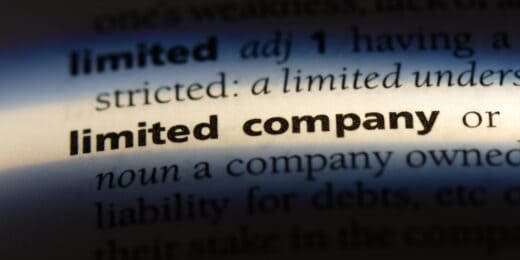Limited companies and limited liability partnerships (LLPs) share many characteristics. They must incorporate (register) at Companies House, they provide limited liability protection to their members (owners), and they have more complex filing and reporting requirements than unincorporated businesses like sole traders and traditional partnerships.
However, there are significant differences to take into consideration when deciding whether to run your business as a limited company or an LLP, such as:
- Taxation of profits
- Tax-planning opportunities
- Flexibility of internal structure and members’ rights
- Capital investment opportunities
- Whether the business will be for-profit or not-for-profit
Choosing the most appropriate legal structure depends on the kind of business you currently have (or plan to have in the future), whether you want to run the business alone or with other people, and which business model offers the best taxation options.
Key Takeaways
- Choose a limited company for tax efficiency and capital investment opportunities in profit-making ventures.
- Opt for an LLP if you value flexible internal structures and equal rights among a small group of partners.
- Understand that LLP members face higher personal tax liabilities compared to limited company directors benefiting from dividends.
Limited companies
A limited company is the most tax-efficient structure for many types of businesses. If you plan to set up a profit-making business, a company limited by shares is the ideal choice. This structure also provides the option to sell shares in the business in exchange for capital investment.
If you’re setting up a charity or non-profit organisation, on the other hand, a company limited by guarantee would be best. There are no shareholders or shares in this type of company because all surplus income (profit) is generally reinvested in the business.
Limited liability partnerships
The limited liability partnership format was introduced in 2001 by the LLP Act 2000 to meet the needs of certain professionals who usually form traditional partnerships, such as solicitors, accountants, and architects. This business model provides the same benefits as a traditional partnership, but it has the added advantage of limited liability protection.
An LLP structure is a good choice for businesses with few (if any) employees and only a few partners, each of whom makes similar contributions to the business, enjoys equal rights and responsibilities, and takes a similar share of business profits.
The main differences between a limited company and an LLP
To determine which structure is best for your business, it’s important to understand the key differences between a limited company and an LLP. We outline these below, but we would advise speaking to an accountant before making a decision.
Ownership structure
A limited company can be registered, owned, and managed by just one individual who can be both the sole member (shareholder or guarantor) and sole director. Alternatively, a company can have any number of directors and members.
To set up an LLP, you must have a minimum of two LLP members. One way around this is to set up a dormant company as the second LLP member. However, if you want to set up and run a business by yourself, a limited company would be the better choice.
Limited liability
The liability of company members is limited to the nominal value of the shares they hold or the financial guarantees they provide.
The liability of LLP members is limited to the amount each member guarantees to pay if the business runs into financial difficulty or is wound up.
Loans and investments
A limited company can receive loans and capital investment from outside investors. Whereas, an LLP can only receive loan capital. It cannot offer equity shares to non-members because LLPs do not have shares.
Tax on profits and personal income
Tax efficiency is often the main consideration for many business owners when deciding on the best legal structure to use. Taxation of profits and personal income is one of the most significant differences between limited companies and LLPs.
Limited company tax
- Limited companies pay Corporation Tax on all taxable income after the deduction of expenses.
- Directors’ salaries are not liable to Corporation Tax, but they are subject to Income Tax and National Insurance contributions (NICs).
- Typically, directors are also shareholders, which means they are entitled to dividends from shares. Dividends are paid from post-tax profits, and the first £500 of dividend income is tax-free. Above that sum, dividends are subject to dividend tax, which provides more favourable rates than Income Tax.
- By taking a director’s salary up to your tax-free Personal Allowance (up to £12,570 per year) and withdrawing the remainder of your income as dividends, you will pay less personal tax than you would as a sole trader or an LLP member.
Dividend Tax Calculator
Limited companies provide additional tax-saving opportunities if you have surplus income that you want to reinvest in the business or withdraw in future tax years. This means that you can deduct capital allowances from your taxable profits if, for example, you purchase new business equipment.
In terms of personal tax savings, you can delay certain dividend payments until the new tax year to avoid paying higher or additional rates of Income Tax, or at least delay the higher tax rates until the following year.
These are just a couple of examples of the many tax-saving and tax-planning options available to limited company directors and shareholders, so we would recommend speaking to an accountant or tax advisor for specialist help and advice in this area.
Limited liability partnership tax
- LLP members are treated as self-employed individuals for tax purposes. They have to register for Self Assessment and pay Income Tax and NIC on their individual share of the profits, regardless of whether they take all of this income as a salary or reinvest some of it in the business.
- Depending on the amount of profit generated, the tax liability of LLP members can be rather high. If an LLP member’s income exceeds their tax-free Personal Allowance, they will be subject to the following Income Tax* rates:
- 20% (basic rate) on taxable income up to £50,270
- 40% (higher rate) on taxable income between £50,271 – £125,140
- 45% (additional rate) on income above £125,140
- LLPs do not have to pay employer NICs on members’ earnings unless they are salaried members who are paid through PAYE.
- Regardless of whether members take all of their annual profit entitlement or reinvest some of it in the business, all profit is subject to Income Tax and NIC in the financial year it is generated.
*If you live in Scotland, you will pay different rates of Scottish Income Tax on your share of LLP profits.
Profit distribution
A limited company can be set up as a profit-making business (limited by shares) or a non-profit business (limited by guarantee).
LLPs must be set up with the intention of making a profit, so it is not a suitable structure for charities or non-profit ventures.
Internal management structure
An LLP can offer greater flexibility than a limited company in terms of altering the rights, duties, and profit entitlement of individual members. Such arrangements can be agreed verbally amongst LLP members, and they can be quickly and easily changed at any time.
However, it is commonplace to draw up an LLP Agreement that sets out the internal management structure of the business and the various arrangements in place. This type of formal agreement minimises the risk of internal conflict and disputes.
It is more difficult to change the rights and profit entitlement of shareholders because these provisions are dictated by the prescribed particulars attached to shares. If you want to alter any members’ rights, you will need to alter the prescribed particulars or issue different types of shares.
If you set up a company with more than one shareholder, it is advisable to draw up a shareholders’ agreement to outline members’ rights, responsibilities, and duties.
Please note that the information provided in this article is for general informational purposes only and does not constitute legal, tax, or professional advice. While our aim is that the content is accurate and up to date, it should not be relied upon as a substitute for tailored advice from qualified professionals. We strongly recommend that you seek independent legal and tax advice specific to your circumstances before acting on any information contained in this article. We accept no responsibility or liability for any loss or damage that may result from your reliance on the information provided in this article. Use of the information contained in this article is entirely at your own risk.








Join The Discussion
Comments (23)
Good afternoon
My friend and I, are in the process to set up our own business and would like to get some advices regarding the type of company would be suitable to use:
1. We want to register our company and choose the company name, but we are not sure if it must be under the partnership LTD or LLP or another category. We want to understand the pros and cons of the registration process.
2. Once we’ll decide under which registration type, we will set up our company, We want to know step by step:
– How to register our company.
– What we need to do the to carry on with the self-assessment., etc.
3. Is it compulsory to hire an accountant from the beginning or it is ok to hire his services near the taxable period? Of course, I understand that we need to keep record of all the income and outcome generated during the business during the year.
4. Can We buy insurance indistinctly the type of company is selected?
5. We have heard about the app called Tide (Bank), how secured it is, if we use this bank services and how does it work?
Thanks in advance for your help
Regards
Thank you for your kind enquiry, Lenni.
Given the broad range of questions you have asked, I would recommend you speak to one of our advisors on 020 7871 9990, message us on live chat, or send an email to info@rapidformations.co.uk – we will be happy to answer any questions you may have.
We look forward to hearing from you soon.
Kind regards,
Rachel
2 self employed people decide to work together and split all profits 50/50.
They continue to carry out other works for themselves under their sole trader status so their personal allowances are taken up by this work.
Would a LLP be more beneficial than a ltd company with two shareholders ? With regard to any dividends that could be taken from the Ltd company
Dear Stephen
Thank you for your message. The question you have is a question for an accountant. We are not accountants so are not able to advise you in this case.
Best regards,
Rapid Formations Team.
Hi, the blog says that the liability of LLP is limited to the amount each partner guarantees to pay if the business runs into financial difficulty or is wound up. How and where do you define and declare that amount?
Dear Nicholas,
Thank you for your message. The limit of liability in an LLP will be laid out in an LLP agreement which should be agreed on by all partners.
Best regards,
Rapid Formations Team
Can all partners in an LLP be limited companies ?
Hi Quinton,
Yes, I believe it is possible to set up an LLP with all corporate members, but I would advise checking with Companies House to be absolutely certain that this is still the case – you can call them on 0303 123 4500.
Best wishes,
Rachel Craig
Hello Rachel,
I would like to set up an immigration consulting/ overseas visa services company with my partner. There is no investment needed as we provide advisory services and visa services for different countries. What do you think will be the best option to use? LLP or limited company?
Dear Shah,
Thank you for your message. The type of business you are intending run operate does not favour any particular type of entity. Most of the limited liability entities set up in the UK are limited companies and I would suggest this would be fine for your needs.
Best regards,
Rapid Formations Team.
Hi!
I am planning to start an architecture practice on my own. I will be working initially on small residential projects (from home) but it seems that I might get a very important project of approx £3m in the future (in about 6 months).
What would you recommend to set up as? I believe that setting up a LLC is the way forward as I haven;t got a partner? Can you please give me some advice?
Thank you
Hi Alicia,
A limited liability company may be the best option but I would strongly advise consulting a professional adviser or accountant before making a decision – they will be able to discuss your options based on the future plans of your firm.
Best wishes,
Rachel Craig
How does a dormant Ltd company work within an LLP? Could the Ltd company be used in the future – if so how?
Would that be tax efficient in the future using it for distribution of dividends? (bearing in mind the additional costs in running the company!)
Many thanks
Hi Angus,
Could you clarify what you mean – are you referring to using a dormant company as an LLP member to allow you to set up an LLP as the only human partner?
Thanks,
Rachel
I WANT TO START A MULTI BUSINESS FIRM LIKE SAHARA IN PARTNERSHIP THAT TO FUTURE PLAN IS FOR PUBLIC COMPANY.I HAVE FUND CRISIS NOW FOR OPENING A COMPANY SO WHICH ONE SHOULD I START I.E PARTNERSHIP/LLP/LLC/LIMITED/PVT LIMITED AS I WANT MY BANK ACCOUNT SHOULD BE IN ONE NAME & REST WORK SHOULD BE IN ANOTHER NAME.
Hi Anish,
I’m afraid I cannot make any professional recommendations to you because I do not know the particulars of your business or future plans. I would recommend speaking to an accountant because it sounds as though you have big plans for this business venture – you will require tailored, professional advice from the outset.
Best wishes,
Rachel Craig
If the entity (a financial services intermediary) has overseas investors, which legal status would be more appropriate and tax efficient LLP or Private Ltd Company?
That is one thing I wonder as well. Assuming all the shareholders are overseas residents, which of these two types you think is makes more sense?
Dear Sir
Thank you for your message.
We are not accountancy or taxation advisors so cannot give guidance on the best structure for your business and would advise that you discuss requirements of this nature with an accountant.
Kind regards
I have a limited company. My company has 2 parthners, with equal shares of 50%. My parthner has decided to leave because he cannot afford to pay the expenses of the company. my company has not started yet so what so I need to check to make sure that he has transferred everything under my name?
Hi Ruchika
Thank you for your message.
If the other director/shareholder is leaving the company they would need to resign from the company by following the appropriate procedures of informing the company first of the intention to resign and then the removal being approved. Companies House would then require to be notified of the changes.
If the person is giving up his shares then an Annual Return should be completed and filed with Companies House to reflect the changes.
Kind regards
How do I determine the number of shares in a company being set up?
Hi Harley, a good general rule is to issue 100 shares in a company. This means that each share represents 1% ownership in the company. This way it is easy to distribute shares among shareholders and you should not need to issue any extra shares further down the line. For more information, have a look at this blog on share issues – https://www.rapidformations.co.uk/blog/company-formation-how-many-shares-should-i-issue/
Thanks!